Source: Farm and Dairy
The Asian longhorned tick, first detected in Ohio in 2020, has now spread to 21 counties, raising serious concerns for cattle producers. This invasive arachnid can transmit Theileria orientalis, a parasite that causes theileriosis in cattle. Infected animals may develop fever, jaundice, respiratory distress, reduced appetite, stillbirths, or even death. In severe infestations, ticks can kill cattle outright by blood loss, as seen in Monroe County in 2021.
With no treatment for theileriosis, prevention and monitoring are critical. To improve detection, Ohio State University launched the Buckeye Tick Test, a public service that identifies tick species and pathogens, helping veterinarians and farmers respond quickly. Researchers also conduct surveillance and on-farm studies to better understand the tick’s life cycle in Ohio. Farmers are urged to manage tick habitats through mowing, pasture management, targeted pesticides, and frequent animal checks. OSU emphasizes integrated pest management as the most effective strategy to protect herds.

